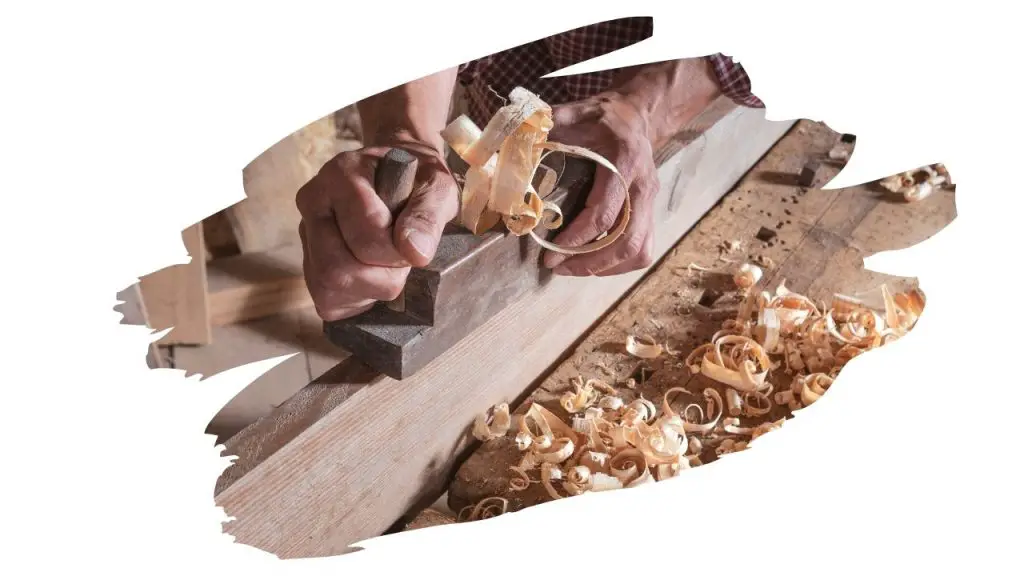There are wide variety of plywood types available, from the most popularly used softwood plywood (typically source from cedar, pine, or spruce), to the water resistant ‘Marine Plywood’.
This incredibly versatile timber is used for everything from paneling to roof decking, and it can be bought in a range of thickness levels.
But if we want to plane plywood down (and get the thickness just right for our woodwork projects), what tool should you use?
In other words, can you use a hand planer on plywood? Yes, you can use a planer on plywood, but the glue holding the sheets of ply together can start to dull the metal edge of the hand planer.
You see, plywood adhesive glue can gum up an otherwise sharp planer as you work the hand tool along the board.
Also, planing plywood cross grain (rather than along the grain) can cause the layers to pull apart.
However, if you keep reading, we will dive into the best ways to plane plywood (without ruining the wood in the process)…

This post may contain affiliate links to products that we receive a commission for (at no additional cost to you). Learn more here.
How Do I Reduce The Thickness of Plywood?
You can reduce the thickness of plywood in a range of different ways (none of which involve using a hand plane). Here are a couple of ideas you can try;
- Use a Block Plane
Using this palm sized hand tool will allow you to take tiny chips off the plywood.
- Use Sandpaper
Running 150-grit sandpaper along plywood can allow you to reduce the thickness of the wood without ripping through each veneer layer.
If you want to learn more about all the different ways you can reduce the thickness of plywood, (without using a hand planer at all), then click here to learn more: How To Reduce The Thickness of Plywood (Explained)
What About Chiseling? Can You Chisel Plywood?
If you want to use a chisel on plywood, you are going to need to use an incredibly light touch, and a set of paring chisels.
Paring chisels are chisels that are not struck with a hammer or a mallet. Instead, you place pressure on the paring chisel by hand.
A typical chisel set (which will often include a paring chisel or two), will set you back around $20 or so.
However, if you want a set of paring chisels designed for very delicate chiseling jobs – such as chiseling into plywood – then a set of Japanese chisels could turn out to be a better option.
Japanese chisels are uniquely different from typical chisels due to the fact that Japanese chisels have a hollow-ground section at the back of the chisel. This hollow characteristic is referred to as an Ura or Urasuki.
The hollow makes it easier to keep these chisel types extra sharp.
However, Japanese chisels are pricier in comparison to their European counterparts. You can expect to pay up to $300 for a set of six.
Can You Run Plywood Through A Jointer?
General rule of thumb? Yes, you could, but you probably shouldn’t. And, once again, the problem lies with plywoods rigid glue.
If you try and run plywood through a jointer, you risk messing up your jointer tool. Why? Well, because plywood’s adhesive glue will more than happily mangle and damage the jointer.
And, as any good woodworker will tell you, plywood glue is nothing to mess with. Once dried, this formaldehyde-based solution solidifies into a very stiff resin.
Wrapping It All Up!
Hand planes can be a quick and easy way to reduce the thickness of wood. Still, when it comes to using hand planers on plywood, my advice is that you:
- A) Only plane small sections of the plywood at a time, and avoid going cross-grain.
- B) Pause regularly to clean and re-sharpen the planes metal edge.
- C). If you can, try and buy plywood that is already at – or as close enough to – your desired thickness.



